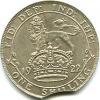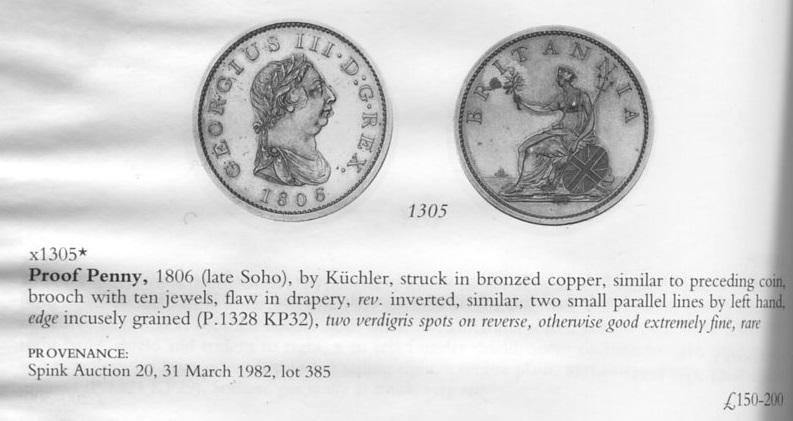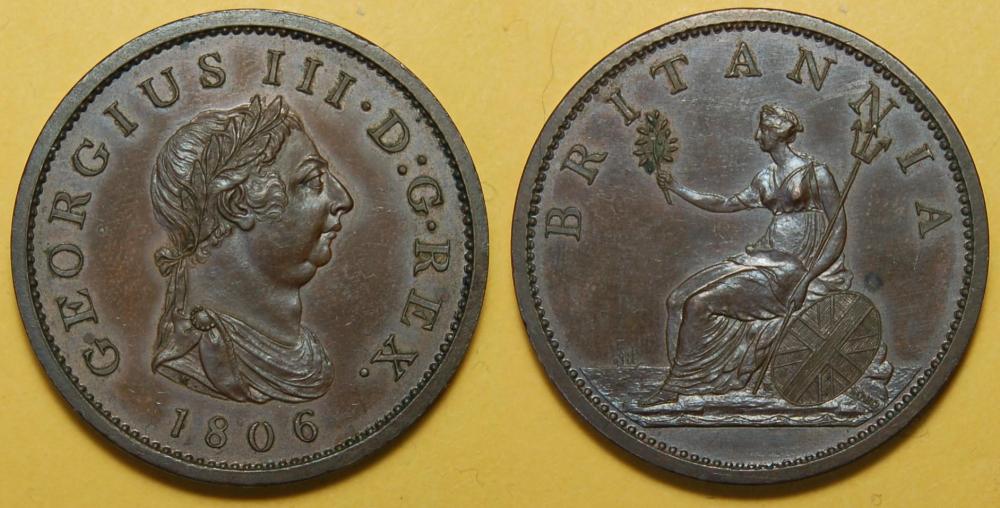|
|
The current range of books. Click the image above to see them on Amazon (printed and Kindle format). More info on coinpublications.com |
|
|
-
Content Count
12,471 -
Joined
-
Last visited
-
Days Won
291
Posts posted by Rob
-
-
Just now, SilverAge3 said:As an aside, what does Selig 1305 refer to?
Selig collection of coins sold at Spink on 2nd March 1999. That coin was lot 1305 - see attached image from catalogue. And thanks for asking the question as I discovered my chimney has a leak, soaking the edge of the catalogues for sales 127 to 133. It's been wet recently.
-
In the case of the two coins pictured above, the photo has been done so as to maximise the reflectivity of the field and produce as much of a cameo effect as possible. That doesn't help to show the colour as in hand. Lighting angle, picture angle, surface reflectivity all combine to give a multitude of options. This pattern halfpenny is really dark in hand, but lit from a certain angle is like an oil painting.
-
 1
1
-
-
15 minutes ago, secret santa said:Bronzed specimens tend to look a browny-pink (see below).
There is quite a lot of variation in the colour of bronzed proofs. Soho and Royal Mint bronzing is normally darker than Taylor's restrikes, which can be a bit blotchy in nature.
-
 1
1
-
-
-
Happy New Year
-
 3
3
-
-
George III coppers are divided into 4 discrete types by design. 1st issue comprises the halfpennies and farthings 1770-5 (no pennies) not struck in a collar; 2nd issue is the 1797 pennies and twopences (no currency halfpennies or farthings) - the 'Cartwheel' issues; 3rd issue is the 1799 halfpennies and farthings (no pennies) and 4th issue is the 1806-7 pennies, halfpennies and farthings (both with different portraits and reduced weights due to the copper price increase during the Napoleonic Wars).
-
 4
4
-
-
-
40 minutes ago, DrLarry said:the worst one I had was a beautiful 1837 penny which was slabbed in fact a half penny..... you just can't get the staff....
At that point you keep your mouth shut and bid strong.
They do have staff - just the wrong sort.
-
 1
1
-
-
A very Merry Christmas to all.
-
 7
7
-
-
I'd say Richard II York early style type 1 with London dies. This based on the obverse having a lis on the breast and wide hair, with the reverse having a saltire before CIVI and the pellets in angles not being joined to make trefoils. Spink 1690.
-
 3
3
-
-
Y or y was the mark of Sir John Yorke who was at Southwark. It seems pretty conclusive given other marks tie in to specific people at this time. Bow - Sir Martin Bowes, t - William Tyllsworth, TC - Thomas Chamberlayne, WS William Sharrington, while Edmund Peckham (Treasurer) is assigned the ostrich head and G(all coins overmarked) for George Gale at York where coins were never struck, though dies were prepared.
-
 1
1
-
-
The rim is different by DG and MEV. Not the same items.
-
They only book at £10 Unc or £35 BU, whatever that difference means, but I can't shift them at 35 (maybe 25-30), so given £700 hammer is £868 with juice, who in their right mind would pay 30x market rate for one of these?
-
11 hours ago, TomGoodheart said:Steven Hill. Reverse might give more clues?
Not sure when he was at Baldwins and when he left. Rob might know?That's relatively easy. His last day at Spink I believe was 7/7/2005 which is obviously easy to remember. Sovereign Rarities have been around since 2016?
-
 1
1
-
-
Which wouldn't be a first. I've got the Charles I F3/1 previously discussed on this forum, and someone I know has the original Edward I Newcastle class 9 that cropped up on numerous occasions. All the originals have to be out there somewhere.
-
 1
1
-
-
They were both at Huddersfield on Sunday, as usual.
-
1 hour ago, oldcopper said:"They're on majestic plains" was it?
'Charging majestically across the Savannah', I believe.
-
 1
1
-
-
I would say G1/2 on the grounds of the little circular detail towards the bottom of the bust, but the detail is not brilliant. There are two G bust types which look like these below, with the G1 bust having the lace detail mentioned. The reverse is definitely 2 on account of the cruder cross ends. Assuming a G1 bust, these were struck in triangle, star and triangle in circle marks which cover 1639-43. The mintmark is immediately to the left of CAROLVS and off flan on the reverse above the shield. If you can see a curved arc, then T in C it is, struck 1641-3. That is the commonest mark.
It's struck in 0.925 silver, weighed approx. 6 grams when made and in that condition speaking from a numismatic point of view, worth maybe £10-15. It would have near zero appeal to a coin collector because of its condition and is worth more as part of the ladle.
-
 1
1
-
-
-
Make your own. The number of variations in mint and moneyer names is extensive with variations for most mints and names. Every year we discover new moneyers for a particular mint or a new type for a mint.
I've got a Cnut short cross of Lincoln by the moneyer PEDLOVS, or is it Waldos (as in North), or is it PEDLOS? It is thought that the actual name is WATHLAUSS, which is a Nordic name. Sometimes they doubled up on a letter to ensure there were no spaces in the legend to allow someone to change it. Chester is all over the place. Dorchester is represented by two moneyers for William I Sword type - GODPINE and OTER. The first uses DORC, DORE & DORI and the second DORECES, DORECST and DORECSTI on account of his shorter name. That's a lot of varieties for the scarcest issue from a small 2 moneyer mint! Overall, it's a mess.
-
 1
1
-
-
The BNJ drew a blank, so when I have time I'll have a quick look through the Circular Index to see if there's anything in vol.38, but all is currently stuck behind a 2 deep 2-3 foot stack of Leu, Baldwin's, St. James's and Glens catalogues!
-
-
It could be connected to the fourth variety discovery or an example from an image. I thought it might have been a reference to the Cloncreen Bog hoard of 60 Elizabethan coins found in Co. Offaly in 1968, but there wasn't an Anchor in there (latest was Key), so I'm not sure yet.
-
It requires people to retain all their notes and correspondence which doesn't happen very often. I have to confess I am remiss in that department, but I always keep any notes acquired that I can attribute or provide useful information.
Edited to add that 10 years ago(?) or so, there was a lot in a London sale (forget which one) which had a Shepherd catalogue (1885) and a few other things. Anyway , I bid 3 or 400 and was surprised to subsequently find out it had all Shepherd's correspondence which wasn't noted hence the nearly £2K it made. Not being in London meant no viewing. Had I known, I would have gone down for a day to go through it. Apparently there was quite a lot of material. So it is out there if you keep your eyes open.
 Coinpublications.com
Coinpublications.com









Rob Page Henry3.com website???
in British Coin Related Discussions & Enquiries
Posted
Build your own databases and get a proper library. Even just copying and pasting the info into your own reference file negates the inherent issues with sites dedicated to a narrow focus. All these nerd sites have one thing in common. When the person responsible loses interest in a field they have researched, so does their interest in keeping the site going.